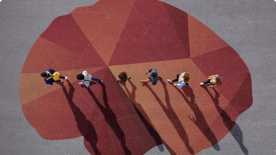Challenges


When a clever joke makes you laugh, your brain is doing at least five different things — sensory processing, perspective taking, assessing incongruous information, finding it funny and then creating a response, says Amit Sood, a professor of medicine at the Mayo Clinic in Rochester, Minn., and author of The Mayo Clinic Handbook for Happiness: A Four-Step Plan for Resilient Living.
The three areas of the brain most intimately involved in laughter are regions responsible for cognition, emotions and motor skills, he says.
Take this joke: A teacher asked her students to use the word "beans" in a sentence. "My father grows beans," said one girl. "My mother cooks beans," said a boy. A third student spoke up: "We are all human beans."
The reason it's funny is that it sets you up to think each answer is going to be about the food item, but the incongruity comes when the kid's answer misuses the term "beans."
The cognitive parts of the brain (particularly the inferior frontal and inferior temporal gyrus, but also other areas) help you understand the meaning of the words and find incongruity, he says.
The emotional parts (particularly the medial prefrontal cortex, the amygdala and mesolimbic reward regions) help you find it funny and generate a feeling of mirth, Sood says.
This feeling then is expressed by the motor part (mainly, the primary motor and premotor cortex, both part of the frontal lobe) of the brain that stimulates the muscles of the face, diaphragm and sometimes the whole body, he says.
Research shows that happier people tend to be more creative, have greater motivation and recover faster from neurological illness, Sood says.
The important thing to know about laughter is that it is social, says researcher Robert R. Provine, a neuroscientist and professor of psychology at the University of Maryland, Baltimore County, and author of Curious Behavior: Yawning, Laughing, Hiccupping, and Beyond.
His research shows that laughter occurs 30 times more often in social situations than solitary ones. When people are laughing with each other, they are interacting brain-to-brain, he says.
Usually people chuckle when they are involved in playful interactions with others. It's about relationship more than humor, Provine says. "Only 10 to 15 percent of laughter follows comments that are remotely joke-like."
And it's contagious. Laugh tracks in sitcoms work because they trigger others to chuckle. If you hear "ha-ha-ha," you are likely to join in, Provine says.
To get the most benefit out of laughter, Sood has three suggestions: Laugh with and not just at things; learn to laugh at yourself; and surround yourself with people you trust and love.











More From Staying Sharp
Practice Self-Compassion
For greater well-being, be kind to an important person: you
Social Connections May Help Cognitive Function
More socially active older adults tend to have better cognitive function
7 Simple Stress Busters to Try Today
Ease tension and anxiety with these science-backed tactics